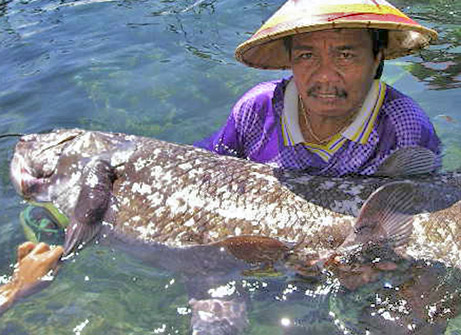Coelacanth, the Living Fossil in Manado
Coelacanth is the name of an ancient fish species, later known as living fossils. The name of the coelacanth comes from the Greek coelia (κοιλιά = hollow) and acanthos (άκανθος = thorn) means "thorns are hollow." This refers to the spine fins are hollow) The remark is that [the ː lə ˌ kænθ]. This is the name order (nation) of fish among others, consists of an evolutionary branch of the oldest surviving fish berahang. coelacanth estimated to have been extinct since the end of the Cretaceous period 65 million years ago. But in 1983, this ancient fish specimens found in eastern South Africa, in the waters of the river Chalumna. Then in 1998, scientifically found in the waters of Bunaken in Manado City North Sulawesi Indonesia. Then followed the other findings in the Comoros, the waters of Manado Tua island of Sulawesi, Kenya, in Tanzania, Mozambique, Madagascar and the marine park St. Lucia in South Africa.
The discovery in waters off Manado is not really new in 1998. Therefore, it is often the fishermen in these waters to catch fish either by hook or by net. Therefore, this fish so familiar with local communities. Fishermen in Manado called by the name of coelacanths is “ikan raja laut” (Sea King Fish).
Until now, there are two living species of coelacanth has been found in the Comoros coelacanth with scientific name as Latimeria chalumnae and Sulawesi (Manado) Coelacanth with the scientific name Latimeria menadoensis.
The discovery of the coelacanth in South Africa began when caught by shark nets in advance Chalumna River estuary in December 1938. Seine vessel skippers are interested in seeing these strange fish, and then sends it to the museum in the town of East London, led by Ms. Marjorie Courtney-Latimer. An local ichthyologist, Dr. J.L.B. Smith then describe the fish and publish his article in the journal Nature in 1939. He gave names to the new species fish as Latimeria chalumnae, to commemorate the museum curator and the location where the discovery of fish.
In Manado gulf, before the meeting of the World Ocean Conference (WOC) in May 2009 and Sail Bunaken in August 2009 , several times found by local fishermen and underwater survey by a team of experts from the University of Sam Ratulangi Manado together experts from Japan. If fishermen find it by accident because of entanglement or hook, then found by a team of experts to conduct research and diving or using the robotic camera and video recording.
The discovery in waters off Manado is not really new in 1998. Therefore, it is often the fishermen in these waters to catch fish either by hook or by net. Therefore, this fish so familiar with local communities. Fishermen in Manado called by the name of coelacanths is “ikan raja laut” (Sea King Fish).
Until now, there are two living species of coelacanth has been found in the Comoros coelacanth with scientific name as Latimeria chalumnae and Sulawesi (Manado) Coelacanth with the scientific name Latimeria menadoensis.
The discovery of the coelacanth in South Africa began when caught by shark nets in advance Chalumna River estuary in December 1938. Seine vessel skippers are interested in seeing these strange fish, and then sends it to the museum in the town of East London, led by Ms. Marjorie Courtney-Latimer. An local ichthyologist, Dr. J.L.B. Smith then describe the fish and publish his article in the journal Nature in 1939. He gave names to the new species fish as Latimeria chalumnae, to commemorate the museum curator and the location where the discovery of fish.
In Manado gulf, before the meeting of the World Ocean Conference (WOC) in May 2009 and Sail Bunaken in August 2009 , several times found by local fishermen and underwater survey by a team of experts from the University of Sam Ratulangi Manado together experts from Japan. If fishermen find it by accident because of entanglement or hook, then found by a team of experts to conduct research and diving or using the robotic camera and video recording.



